
Pollock or pollack is the common name used for either of the two species of North Atlantic marine fish in the genus Pollachius. Pollachius pollachius is referred to as "pollock" in North America, Ireland and the United Kingdom, while Pollachius virens is usually known as saithe or coley in Great Britain and Ireland. Other names for P. pollachius include the Atlantic pollock, European pollock, lieu jaune, and lythe or lithe; while P. virens is also known as Boston blue, silver bill, or saithe.
Ophidiiformes is an order of ray-finned fish that includes the cusk-eels, pearlfishes, viviparous brotulas, and others. Members of this order have small heads and long slender bodies. They have either smooth scales or no scales, a long dorsal fin and an anal fin that typically runs into the caudal fin. They mostly come from the tropics and subtropics, and live in both freshwater and marine habitats, including abyssal depths. They have adopted a range of feeding methods and lifestyles, including parasitism. The majority are egg-laying, but some are viviparous.

The Squaliformes are an order of sharks that includes about 126 species in seven families.

Demersal fish, also known as groundfish, live and feed on or near the bottom of seas or lakes. They occupy the sea floors and lake beds, which usually consist of mud, sand, gravel or rocks. In coastal waters, they are found on or near the continental shelf, and in deep waters, they are found on or near the continental slope or along the continental rise. They are not generally found in the deepest waters, such as abyssal depths or on the abyssal plain, but they can be found around seamounts and islands. The word demersal comes from the Latin demergere, which means to sink.
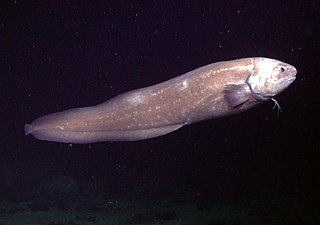
The cusk-eel family, Ophidiidae, is a group of marine bony fishes in the Ophidiiformes order. The scientific name is from the Greek ophis meaning "snake", and refers to their eel-like appearance. True eels diverged from other ray-finned fish during the Jurassic, while cusk-eels are part of the Percomorpha clade, along with tuna, perch, seahorses and others.

Antipodocottus is a genus of marine ray-finned fishes belonging to the family Cottidae, the typical sculpins. These fishes are found in the western Pacific Ocean. This is the only genus of Cottids represented in the Southern Hemisphere, although their classification in the Cottidae is not universally accepted.
Antipodocottus galatheae, the Galathea sculpin, is a species of marine ray-finned fish belonging to the family Cottidae, the typical sculpins. This species found on the continental shelf around New Zealand. It has also been recorded off Tasmania, New South Wales and Queensland.
A blind fish is a fish without functional eyes. Most blind fish species are found in dark habitats such as the deep ocean, deep river channels and underground.
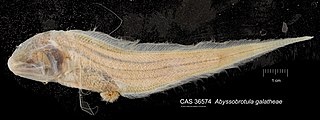
Abyssobrotula galatheae is a species of cusk eel in the family Ophidiidae. It is the deepest-living fish known; one specimen, trawled from a depth of 8,370 m (27,460 ft) in the Puerto Rico Trench in 1970, holds the record for the deepest fish ever captured. Although generally recognized, some have suggested that the record-breaking individual might have been caught with a non-closing net and therefore perhaps caught shallower.
Abyssobrotula is a genus of cusk eel in the family Ophidiidae.

Eels are ray-finned fish belonging to the order Anguilliformes, which consists of eight suborders, 20 families, 164 genera, and about 1000 species. Eels undergo considerable development from the early larval stage to the eventual adult stage and are usually predators.

An anchovy is a small, common forage fish of the family Engraulidae. Most species are found in marine waters, but several will enter brackish water, and some in South America are restricted to fresh water.

Fish are very diverse animals and can be categorised in many ways. Although most fish species have probably been discovered and described, about 250 new ones are still discovered every year. According to FishBase about 34,800 species of fish had been described as of February 2022, which is more than the combined total of all other vertebrate species: mammals, amphibians, reptiles and birds.
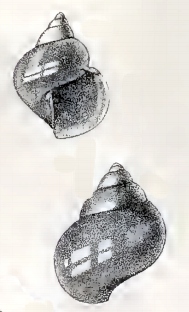
Guttula is a genus of sea snails, marine gastropod mollusks in the family Seguenziidae.

Nematalosa is a genus of gizzard shads in the fish family Dorosomatidae. There are currently 11 recognized species.
Bellottia is a genus of viviparous brotulas which is found in the subtropical waters of the North Atlantic, the Mediterranean Sea and the Indo-Pacific.
Bassozetus is a genus of cusk-eels found in Atlantic, Indian and Pacific Ocean.
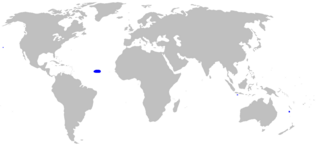
Holcomycteronus profundissimus, also known by its synonym Grimaldichthys profundissimus, is a species of deep-sea fish in the cusk-eel family.
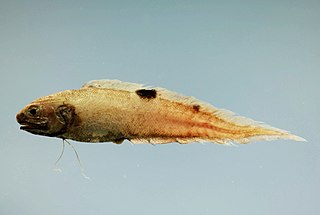
Neobythitinae is a subfamily of cusk eel from the family Ophidiidae. They are mostly fishes of deeper waters, occurring from the continental shelf down to as deep as 8,370 metres (27,460 ft) at the bottom of the Puerto Rico trench where the deepest known fish, Abyssobrotula galatheae, has been taken.
Sciadonus galatheae is a species of fish in the family Aphyonidae.













